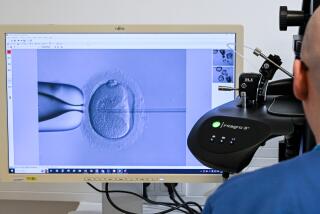Fallopian-Tube Technique for Conception Has Papal Blessing
While test-tube fertilization and other forms of artificial reproduction were condemned by the Vatican this week, a fertility technique pioneered by an Orange County physician apparently has the Pope’s approval.
Dr. Ricardo H. Asch, director of the University of California, Irvine-American Medical International Center for Reproductive Health in Garden Grove, developed the GIFT technique, in which a woman’s eggs and a man’s sperm are injected into the Fallopian tubes, where conception naturally occurs.
The Vatican document issued Tuesday outlaws artificial insemination, embryo and sperm banks, surrogate parenthood and the technology that produces “test-tube babies.” It condemns fertilization that occurs outside the body--such as in-vitro, or test-tube, fertilization--or outside a marriage, such as surrogate motherhood or artificial insemination using the sperm of a man who is not the husband. The document itself did not list specific techniques acceptable to the Vatican.
However, Father Bartholomew Kiely, who teaches moral theology at Gregorian University in Rome and who helped author the document, told a Vatican press conference Tuesday that the GIFT technique, developed in 1984, is permissible.
GIFT is an acronym for gamete intra-Fallopian transfer. Kiely said it is acceptable because the technical means of fertilization is not a substitute for the conjugal sex act.
Asch said Wednesday that couples who wish to respect the Catholic Church’s doctrine are allowed to collect sperm for the GIFT procedure during intercourse. The husband wears a perforated condom-like device that retains seminal fluid for use in the GIFT technique, he said.
The sperm is placed in a catheter next to eggs taken from the wife’s ovaries. But the sperm is separated from the eggs by an air bubble so there is no opportunity for the two to combine outside the body, Asch said. The eggs and sperm then are injected into the Fallopian tubes, where conception naturally would occur, he said.
“We keep the column of air between the gametes, female and male. There is no way they touch before. The origin of life always takes place inside the human body,” he said.
The entire procedure takes about 40 to 45 minutes, with the eggs and sperm outside the body for about 10 minutes, he said.
The procedure is different from in-vitro fertilization, in which several eggs are united with sperm in a laboratory dish and the healthy, fertilized eggs are implanted days later in the woman’s womb.
Many couples suitable for GIFT are infertile for undetermined reasons--as are most infertile couples, Asch said. Among the other problems GIFT can overcome are low sperm count, endometriosis, and a gynecological condition in which the ovarian follicles fail to rupture and release eggs, Asch said.
GIFT can be used in place of in-vitro fertilization in most infertility cases, and Asch claims that his technique has double the success rate of the test-tube process.
According to the Vatican’s document, the technology of in-vitro fertilization violates moral standards.
“Fertilization achieved outside the bodies of the couple remains by this very fact deprived of the meanings and the values which are expressed in the language of the body and in the union of human persons,” the document states.
But the document describes only what is not allowed, not what is permissible.
“We wanted to leave open a category of possible methods and new developments that assist the conjugal act,” Kiely said. “There is so much happening so fast. I can’t be a crystal ball.”
Asch said he could not speak for the Vatican, but he believes his technique meets the church’s approval for several reasons.
“Conception takes place in vivo--in the body,” Asch said of his procedure. In addition, he said, because there are no embryos outside the body, there is no opportunity for the “genetic or embryonic manipulation” the church objects to. In-vitro fertilization can also result in discarded or aborted embryos, but GIFT does not, he pointed out.
Asch and his associate, Dr. Jose Balmaceda, traveled to the Vatican last November to discuss the GIFT technique. While in Rome, Asch consulted with Dr. Nicolas Garcea, professor of gynecology and obstetrics at a Catholic university, and helped the Gemelli Hospital at the Vatican start a GIFT program. As far as he knows, he said, “they are performing it (the technique) successfully.”
The GIFT technique has been used by more than 2,000 couples worldwide, with conception occurring in about 35% of the cases, he said. He is studying the use of the GIFT technique in about 20 countries but believes many other countries also are using it.
The Vatican’s apparent stamp of approval has not immediately brought him acclaim, except among reporters who bombarded his office with telephone calls Wednesday, Asch said. He already has a nine-month waiting list for the GIFT procedure.
Asch pioneered the technique while at the University of Texas Health Science Center in San Antonio. He moved to Orange County last year and is on the faculty of the UC Irvine Medical School.
Asch has also employed the GIFT technique using donated eggs to impregnate women who have been unable to produce eggs of their own because of premature menopause. The donated egg technique, Asch said, does not have the Vatican’s approval.
More to Read
Sign up for Essential California
The most important California stories and recommendations in your inbox every morning.
You may occasionally receive promotional content from the Los Angeles Times.










